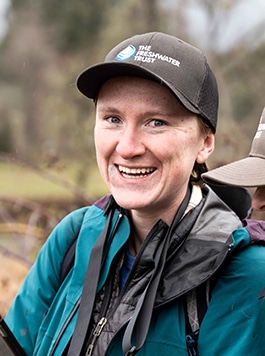Coast Fork Willamette 3.3 Restoration 
The Freshwater Trust (TFT) is an Oregon-based non-profit organization with a mission to preserve and restore freshwater ecosystems. We are currently seeking new restoration projects like this one on the Coast Fork Willamette River. If you own streamside land in our program area that is lacking shade trees, overgrown with blackberry, or otherwise would benefit from restoration of native trees and shrubs for local habitat, we’d love to talk to you. Learn more about the program and eligibility here.
FAQ
The Coast Fork Willamette River Mile 3.3 project is a streamside (or “riparian”) planting project on 3 acres in the Howard Buford Recreation Area (HBRA) in Lane County, Oregon. HBRA is a regionally important natural area that is home to many rare habitats and species, including those that use riparian forests. However, the acreage in riparian bottomland forest has been lost over time in this area. The goal of this project is to generate shade along the streambank by establishing a healthy riparian forest. Shading the river and side channels is important because solar radiation (sunlight) can warm the water too much for native cold-water fish such as salmon, trout and lamprey during critical times in their life cycles. This project helps achieve goals set forth in the HBRA Habitat Management Plan.
Healthy forests provide other benefits in addition to shade, such as erosion control, filtration of excess sediment and nutrients, and pollution reduction. These benefits go beyond the river channel because mature forests look beautiful and provide habitat for wildlife that lives along the river corridor.
Before native trees and shrubs can be planted, invasive weeds such as Himalayan blackberry and reed canarygrass must be removed. This was accomplished in fall 2023 through digging, mowing, mulching, and targeted herbicide treatment. After the area is prepared, several thousand native trees and shrubs of many different species were planted in winter 2024. These plants will help protect the health of the river and the floodplain and side channels in the park. These hydrologically active areas provide valuable recreation opportunities as well as room for floodwaters to go to reduce flood risk downstream.
Pre-project site conditions, July 2023: Invasive weeds like Himalayan blackberry (foreground) can suppress native trees and shrubs from establishing healthy canopy throughout the site.

Post-project site conditions, late winter 2024: Invasive weeds cleared and replanted with native trees and shrubs. Opening the understory allows for natural recruitment of native species in addition to our plantings.


This area is home to an abundance of wildlife, including great blue heron, breeding songbirds, beaver, and many others. Management of riparian forests in the HBRA is designed to help sensitive wildlife targeted for conservation including Upper Willamette spring Chinook, cutthroat and rainbow trout, Oregon chub, northwestern pond turtle, northern red-legged frog and bald eagle.
Trees planted here include black cottonwood, alder, cascara, several species of willow, and others. Shrubs planted here include blue elderberry, Oregon grape, redosier dogwood, Douglas spirea, common snowberry, and twinberry.
Native trees provide shade, while native shrubs protect the landscape from invasion by non-native plants and provide flowers for pollinators and berries that become food for wildlife. Certain species thrive by the water’s edge, while others are more drought-resistant and thrive in the upland. All these plants help to develop a dense, healthy, multi-story riparian forest.
This site will be maintained for 20 years by the Friends of Buford Park & Mt. Pisgah and The Freshwater Trust through the Metropolitan Wastewater Management Commission’s Water Quality Trading Program, which requires projects to meet defined performance standards. Stewardship includes reducing invasive weeds such as Himalayan blackberry, Canada thistle and reed canarygrass from overtaking the project area.
The Metropolitan Wastewater Management Commission of Eugene-Springfield (MWMC) and The Freshwater Trust are partnering to use shade produced from restoring streamside forests to help the utility meet its water quality goals. As the plants grow at each restored site, they block solar load (heat from the sun), which generates “shade (thermal) credits.” These “credits” benefit the MWMC and fish. The MWMC registers them with the Oregon Department of Environmental Quality to comply with a wastewater permit to protect water quality under the federal Clean Water Act, while fish get the benefit of cooler water in the streams.
The Freshwater Trust selects sites using its StreamBank® BasinScout® tool, which prioritizes many potential sites based on different environmental benefits. Sites throughout the Upper Willamette basin are modeled to quantify the amount of thermal benefit (shade) possible under restored conditions. This allows the team to locate the most high-impact planting sites and work with willing landowners to restore them.
The Freshwater Trust closely monitors this restoration project to ensure that it is on track to meet performance standards and to identify stewardship needs. Additionally, sites in the water quality trading program have independent third-party verifiers that confirm that the site is meeting its performance targets and generating the environmental benefits needed to comply with the wastewater permit requirements.
This project covers 3 acres on the south bank of the Coast Fork Willamette River.

Get in touch
Have questions about restoration in the Upper Willamette watershed?
Alexis Graves, Restoration Program Coordinator

Contact Me At
Eugene Oregon
Email Alexis
